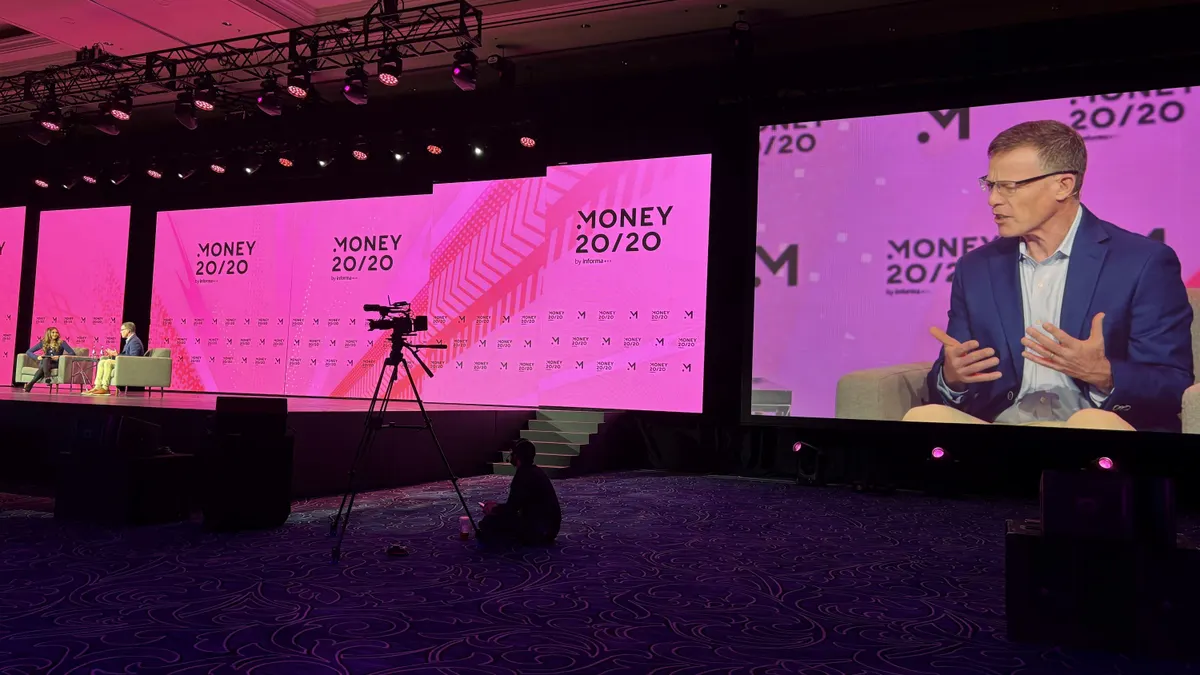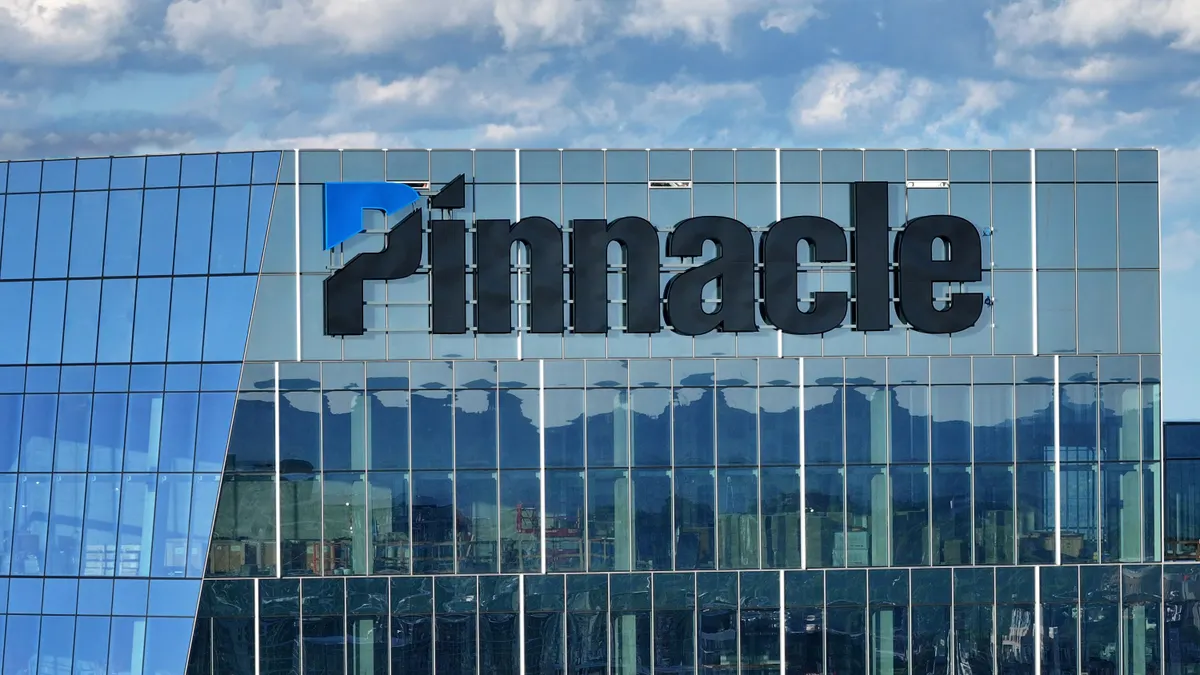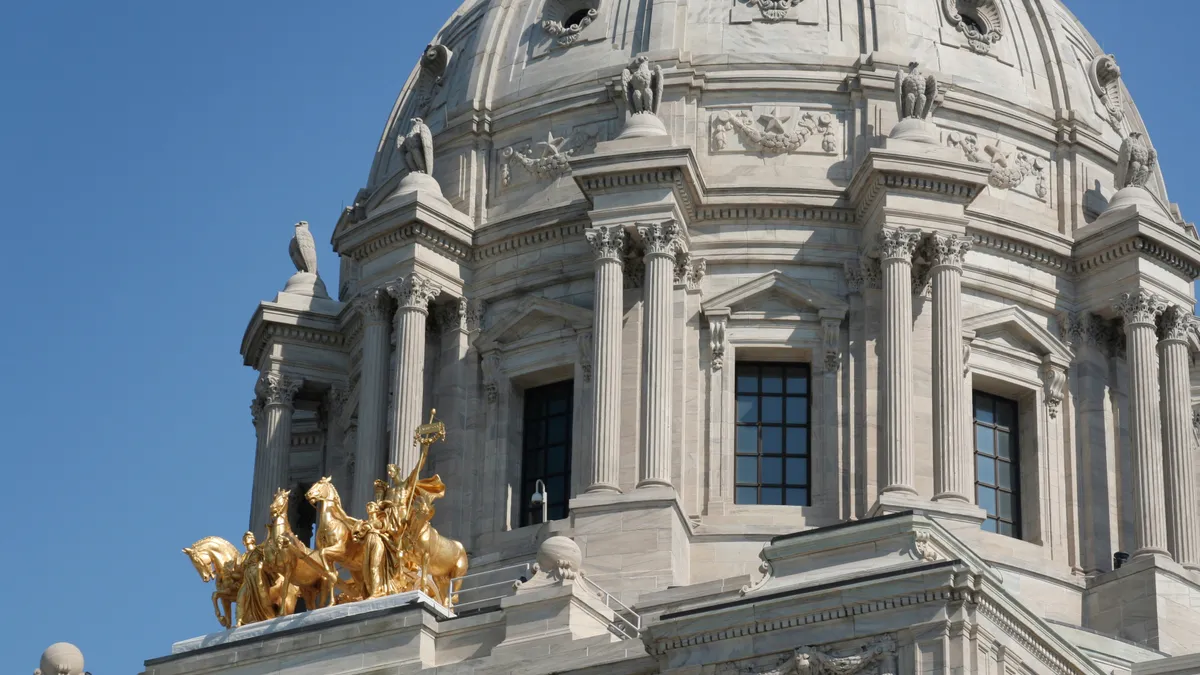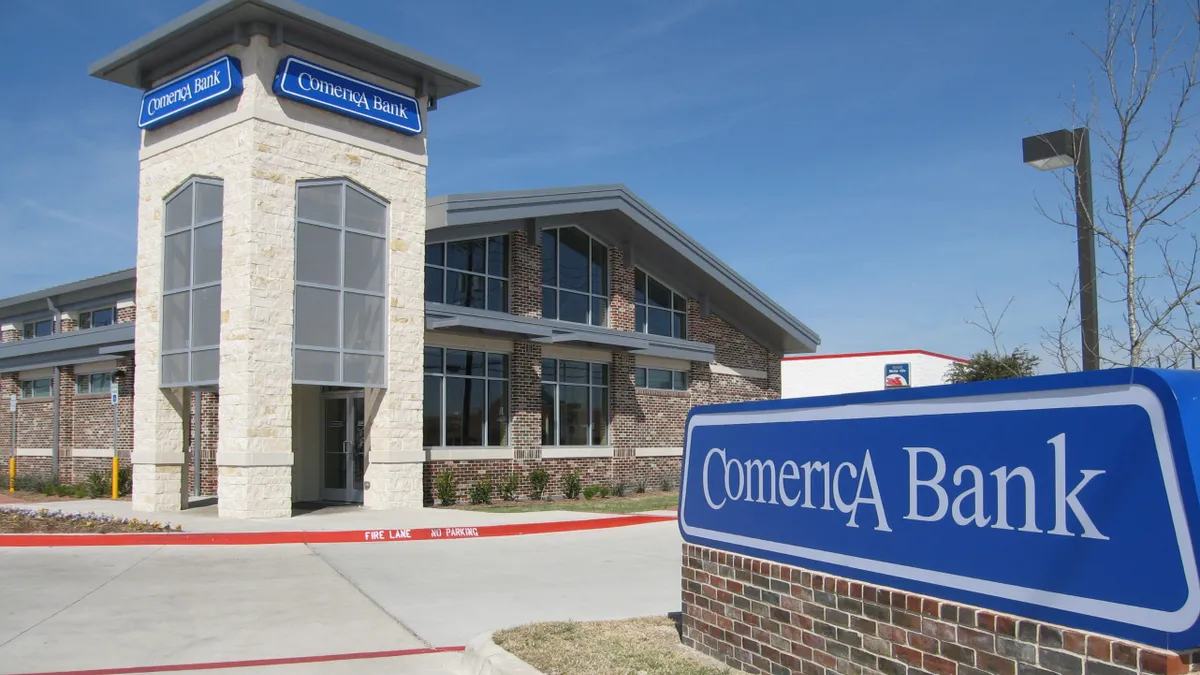Ever since November’s presidential election cemented Donald Trump’s return to the White House, speculation has been rife that the banking sector would see a downturn in regulation, an uptick in mergers and acquisitions, and a boost in the profile and credibility of cryptocurrencies. If these early days of 2025 seem like a wait-and-see period, there may be something to that. But observers have learned from Trump’s first term that change can come quickly and furiously once the new administration takes hold.
Here are a few areas where Banking Dive anticipates new developments in the upcoming year.
Regulation
Financial regulators have adopted wildly varying attitudes in the post-election weeks. Trump made no bones of his distaste for the Securities and Exchange Commission’s current regime, saying as early as last July that he would fire SEC Chair Gary Gensler. Gensler was among the first financial regulation chiefs to signal he would step down. The SEC – and the Commodity Futures Trading Commission, too, for that matter – has remained relatively quiet.
On the other end of that spectrum is the Consumer Financial Protection Bureau, whose chief, Rohit Chopra, has refused to give a resignation date and whose agency has gone into regulatory hyperdrive, issuing final rules on open banking and overdraft fees, and taking legal action against three big banks and the peer-to-peer payments platform Zelle.
Other regulators appear determined to tie up various loose ends – though perhaps not with the CFPB’s level of zeal. The Office of the Comptroller of the Currency issued enforcement actions in December against USAA and Bank of America. The Federal Reserve signaled it would tweak its stress-testing process.
The risk with issuing rules at this point is that a newly sworn-in Congress could try to revoke any number of them within a 60-day period under the Congressional Review Act.
And there are specters, too, of work undone. The Fed’s long-running effort to spearhead a revamp of capital requirements effectively died before the election – and the regulator most associated with it, Fed Vice Chair for Supervision Michael Barr, has agreed to step down from his role Feb. 28.
De-regulation at the federal level may push state regulators to step up. Adrienne Harris, the head of New York’s Department of Financial Services, said in December that a rollback in federal regulations would “certainly increase the volume of consumer protection cases that we may bring on the enforcement side.”
“If there are new gaps that emerge because we don’t have a partner, then we’ll work to fill those gaps as appropriate,” Harris told the Financial Times.
Regulators with a notable Republican presence appear likewise undaunted. The Federal Deposit Insurance Corp., with advocacy from GOP board member Jonathan McKernan, forged a pact with asset manager Vanguard to ensure passive investors wouldn’t interfere with the business decisions of banks.
M&A
Along with the prediction of less strict regulation is the prevailing attitude that mergers and acquisitions will increase in 2025.
Christopher Marinac, director of research at Janney Montgomery Scott, said that while there may be an uptick in combinations of banks with $100 billion in assets or less, megabank deals might be more challenging.
Nowhere will that be on greater display than with Capital One’s proposed $35.3 billion acquisition of Discover. Discover last month refiled its 2023 annual report after fixing an accounting error. That, coupled with a green light on the deal from Delaware’s financial regulator, suggests “remaining approvals are close at hand,” wrote Vincent Caintic, a BTIG analyst, according to American Banker.
Another indicator may come Feb. 18. Capital One and Discover announced a special stockholder meeting on that date to discuss and vote on the combination. The Fed and the OCC are still evaluating the deal, which the companies have said they expect to close in the first quarter.
Deal activity between late October and mid-December, though, indicated a trend toward smaller mergers, Marinac told CNBC.
Marinac stressed the importance of deposits as a driver for mergers, highlighting the potential for banks to expand into new regions and improve earnings through cost savings. That proved a factor in 2024’s richest banking deal: SouthState’s $2 billion acquisition of Independent Bank Group, which opened Texas and Colorado to the Florida-based acquirer.
Merger review processes may be quicker under Trump than in the Biden administration, said Brian Graham, a partner at Klaros Group. And faster decisions will help boards plan mergers, he said.
But the M&A approvals outlook for banks with between $50 billion and $250 billion in assets needs more clarity, Graham noted, adding that it would be “very contingent on the people who are appointed to key positions” at the OCC and the FDIC.
AI
If 2024 was “the year of kicking the tires” with generative artificial intelligence, banks this year are likely to take their initiatives from pilot to production and deploy the technology in banker-facing scenarios, said Zor Gorelov, a senior adviser with Klaros Group.
Other analysts, meanwhile, predict that most consumer-facing projects at banks are unlikely to be greenlit this year, and that generative AI will remain largely internal.
Banks will move away from point solutions and toward bigger-picture looks across entire processes, as the technology is increasingly seen as a growth accelerant rather than a cost-cutting tool, said Chinmoy Bhatiya, an executive director at consulting firm Capco.
Lenders have “become comfortable with the feasibility aspect of it, and it’s more now about confirming the value,” Bhatiya said.
That is, bankers will use generative AI helpers or copilots to better manage their time, and return on investment is expected to become more measurable for banks.
Trump’s reelection portends “a regulatory climate that is much more conducive for banks and other financial institutions exploring AI technology,” said Michael Nonaka, a partner at law firm Covington & Burling. He said he expects it will be easier for banks to adopt AI technologies carefully and strategically.
While many large lenders work to deploy AI, software providers are embedding it into their products. “All of that will impact us,” Bank of America CEO Brian Moynihan said during a December investor conference.
Generative AI’s growing use has enhanced the need for controls that keep pace. As banks invest more in generative AI in 2025 than they did last year, governance will be a key area of focus, said Capco Canada partner Shawn Adams.
Banks are also expected to pursue risk management guidance specific to generative AI, rather than wrapping existing AI risk management frameworks around it.
Anti-money laundering
TD’s headline-grabbing anti-money laundering fiasco last year, culminating in more than $3 billion in fines and an asset cap, has had AML issues front and center.
Watchdogs have since been on high alert for firms running afoul of the Bank Secrecy Act and AML compliance laws, and they’ve dinged banks big and small (and even some fintechs) with enforcement actions.
Amir Fadavi, senior director at global consulting firm K2 Integrity, acknowledged the uptick and said that he expects the trajectory to continue into 2025.
Hogan Lovells partner Liz Boison said the uptick has come in part due to the joint third-party risk management guidance regulators issued last June.
“That really makes banks take a close look at their banking-as-a-service partners and other kinds of fintech partnerships that pose BSA risk,” Boison said.
Additionally, the Justice Department and Financial Crimes Enforcement Network last year beefed up their whistleblower programs, to allow those individuals to receive up to 30% of fines or penalties for flagging BSA/AML violations.
The thing about AML issues, Boison and Klaros Group partner Adam Shapiro both noted, is that they’re bipartisan.
“There's a bipartisan dislike of financial crime and, historically, administrations of both parties take compliance violations and weaknesses seriously,” Shapiro said.
Will another big bank be hit with a sizable, TD-esque AML-related fine in 2025? Fadavi said he “wouldn’t be surprised.”
But these things take time: There are many legs of an investigation, Boison said, and it’s difficult to say how long an investigation into even just one individual could take. The federal investigation that led to TD’s penalties, for example, began in 2021.
Cryptocurrency
2025 will mark a “golden age” for cryptocurrency, crypto index fund provider Bitwise predicted in December.
Prominent coins like bitcoin and Ethereum will reach new values, with bitcoin trading above $200,000, Bitwise predicted – and the U.S. government is expected to legitimize crypto further by passing long-awaited stablecoin legislation and, through the Department of Labor, relaxing guidance against crypto in 401(k) plans.
“In what was previously a hostile and enforcement-driven regulatory environment for the cryptocurrency industry, we expect greater product innovation, customer adoption, and overall crypto enthusiasm going forward as a result of better regulatory and legislative guardrails,” JPMorgan Chase analyst Ken Worthington said in a January outlook.
A friendlier regulatory environment is likely to support “greater experimentation,” including already-underway real-world asset tokenization projects following the momentum of the bitcoin and Ethereum exchange-traded funds last year, said Elizabeth Severinovskaya, managing director at K2 Integrity.
But Jonah Crane, partner at Klaros Group, said the market will likely be more complex than crypto enthusiasts are hoping for.
Because crypto is in the hands of more Americans than ever – in many cases as part of exchange-traded funds that BlackRock and Vanguard put on the market last year – crypto’s boom-bust cycle “could be more painful than the last few have been,” Crane said.
Bernstein analysts led by Gautam Chhugani, however, wrote in a note to investors that the boom-bust pattern should lessen, in part due to crypto’s integration with traditional finance. “Crypto is now firmly on the radar of corporations, banks and institutions, weaving itself into the very fabric of our financial systems,” Chhugani wrote.
Crane also noted that if banks are “given a freer hand to work with crypto companies – or even pressured to do so,” they may increase their exposure to the risks Biden administration regulators warned about all along.
Additionally, while federal regulators may be more amenable to crypto, Trump’s second act could lead to a refrain of his first, in which “states stepped in to fill the enforcement void, creating a complex array of state regulations,” Crane said.
Nonfinancial risks
From deepfake-fueled fraud to geopolitical concerns, the list of nonfinancial risks banks are grappling with may seem longer than ever. But cybersecurity risk will remain at the top in 2025, experts and CEOs said.
“Cyber is by far the biggest risk that we all face,” Wells Fargo CEO Charlie Scharf said during an investor conference in December. “We all are spending a huge amount of money on it.”
“It’s one that industries work together on, governments work together on,” Scharf added. “We just always ask the question, are we doing everything we possibly can?”
Lenders are expected to invest more in cybersecurity this year, pouring resources into cybersecurity personnel and infrastructure investments, and doubling down on efforts to detect and prevent threats.
The risk keeps rising in part because there are more ways than ever through which cyber incidents can occur. There’s “all of these technologies that are bringing together consumers and generating consumer data in ways that weren’t generated 10, 20 years ago,” Nonaka said.
As banks have become better able to withstand financial shocks, nonfinancial risks have garnered more attention, prompting lenders to spend more time considering risks related to cybersecurity and IT, financial scams and anti-money laundering, said David Maya, Accenture’s finance risk and compliance lead for North America.
AI will play a bigger role in banks’ risk management and compliance efforts this year, as they use it to tackle financial crime and reduce false positives, Maya said. But the technology comes with internal risks, too, such as bias and hallucinations.
“That kind of risk, I think, is going to go up and needs to be managed,” Maya said.
Adversarial use of AI is another threat that’s top of mind for lenders, said Matthew Miller, KPMG’s U.S. cybersecurity financial services industry lead. Miller has consulted with more banks recently about deepfakes targeting customers, executives and IT administrators.
“That type of threat and risk is going to continue to increase,” Miller said, “and the technologies are still evolving to be able to protect from that type of risk.”





















